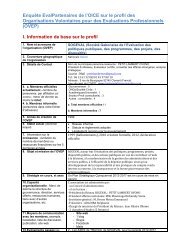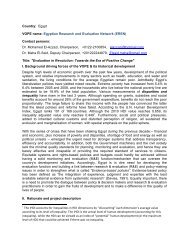8 Sandy Taut<strong>The</strong>re is evidence to support the Jo<strong>in</strong>t Committee's recommendations that care has to be takenwhen apply<strong>in</strong>g the <strong>Standards</strong> as goals for professional conduct outside the North American(‘ma<strong>in</strong>stream’) cultural context.<strong>The</strong> cross-cultural psychological and anthropological literature revealed values reflected <strong>in</strong> the<strong>Program</strong> <strong>Evaluation</strong> <strong>Standards</strong>. Researchers from these fields exam<strong>in</strong>e cultural value dimensionsand a number of other concepts as a way to describe and differentiate cultures. <strong>The</strong> culturaldimensions and concepts used for the analysis of the <strong>Standards</strong> will be expla<strong>in</strong>ed <strong>in</strong> more detail<strong>in</strong> the follow<strong>in</strong>g chapter.A Summary of Relevant Cultural Value DimensionsCross-cultural psychologists commonly dist<strong>in</strong>guish seven culture areas, namely, WestEuropean, Anglo, East European, Islamic, East Asian, Lat<strong>in</strong> American, Japanese (Berry et al.,Vol. 3, p. 105). This dist<strong>in</strong>ction obviously displays a simplified view of the true diversity andnumber of cultures all over the world.As mentioned earlier, cross-cultural literature uses cultural value dimensions tocategorize differences between societies. For example, one of the most widely used andresearched categories is the Individualism-Collectivism dimension. This cultural dimension hasalso been employed by Smith et al. (1993, p. 12) to expla<strong>in</strong> difficulties <strong>in</strong> the applicability of the<strong>Standards</strong> <strong>in</strong> India and Malta. Some additional common dimensions <strong>in</strong>clude Egalitarianism-Hierarchy (or Power Distance), Conservatism-Autonomy and Mastery-Harmony. Empiricalstudies show that these dimensions are valid and reliable (see Berry et al., 1997, Vol. 3). Thispaper will briefly describe these dimensions, followed by a description of other relevant culturalconcepts used <strong>in</strong> this analysis.Individualism-CollectivismPhilosophic trends beg<strong>in</strong>n<strong>in</strong>g with Descartes, followed by British empiricism (Hobbes,Smith), social Darw<strong>in</strong>ism (Spencer), phenomenology and existentialism (Kierkegaard, Husserl,Heidegger, Sartre) made <strong>in</strong>dividualism the hallmark of European social history s<strong>in</strong>ce thethbeg<strong>in</strong>n<strong>in</strong>g of the 16 century (see Berry et al., 1997, Vol. 3, p. 4). In contrast, eastern religionsand philosophies such as Confucianism, Taoism, Buddhism, H<strong>in</strong>duism and Sh<strong>in</strong>toism can beseen as roots of collectivism <strong>in</strong> these cultural sett<strong>in</strong>gs. Early monotheistic religions aris<strong>in</strong>g <strong>in</strong> theMiddle East (Judaism, Christianity, Islam) also emphasize collective loyalties. However, thethEuropean Reformation <strong>in</strong> Christianity (16 century) later <strong>in</strong>troduced <strong>in</strong>dividual responsibility(see Berry et al., 1997, Vol. 3, p. 5). Kagitcibasi (1997, <strong>in</strong>: Berry et al., Vol. 3, p. 5) states that“all societies must deal with tensions between collectivism and <strong>in</strong>dividualism, […] there is someof both everywhere. Nevertheless, differences <strong>in</strong> emphasis appear to be real.”Hofstede (1980) provided a more recent appraisal of the collectivist-<strong>in</strong>dividualistdist<strong>in</strong>ction. He conducted a survey on work-related values with 117,000 IBM-employees from40 (later expanded to 50) countries. A factor analysis revealed four value dimensions:
Cross-Cultural Transferability of the <strong>Program</strong> <strong>Evaluation</strong> <strong>Standards</strong> 9‘Uncerta<strong>in</strong>ty Avoidance,’ ‘Mascul<strong>in</strong>ity,’ ‘Power Distance’ and ‘Individualism-Collectivism.’Hofstede’s (1980, pp. 260f) orig<strong>in</strong>al def<strong>in</strong>itions of the those last two concepts read as follows:“Individualism stands for a society <strong>in</strong> which the ties between <strong>in</strong>dividuals are loose; everyone isexpected to look after himself or herself and his or her immediate family only”; “Collectivismstands for a society <strong>in</strong> which people from birth onwards are <strong>in</strong>tegrated <strong>in</strong>to strong, cohesive<strong>in</strong>groups, which throughout people’s lifetime cont<strong>in</strong>ue to protect them <strong>in</strong> exchange forunquestion<strong>in</strong>g loyalty.”Triandis’ research (1990, p. 113) elaborated on Hofstede’s work. Triandis notes that thedef<strong>in</strong><strong>in</strong>g attributes of <strong>in</strong>dividualism are “distance from <strong>in</strong>groups, emotional detachment, andcompetition,” while he characterizes collectivism as stress<strong>in</strong>g “family <strong>in</strong>tegrity and solidarity.”Based on empirical f<strong>in</strong>d<strong>in</strong>gs, Schwartz (1990, 1994a,b) ref<strong>in</strong>ed the <strong>in</strong>dividualism-collectivismdimension with two higher order dimensions. At the cultural level, these dimensions are‘Autonomy vs. Conservatism’ and ‘Hierarchy vs. Egalitarianism.’ Elaboration on the behavioraldifferences based on the collectivism-<strong>in</strong>dividualism dimension and their relation to the analysisof the <strong>Standards</strong> will be provided <strong>in</strong> a later section of this paper.Similar to Hofstede (1980), Schwartz (1994a,b) conducted a value survey <strong>in</strong>clud<strong>in</strong>g44,000 respondents (us<strong>in</strong>g teachers and students) from 56 countries. After statistical analyses ofthe data he proposed the follow<strong>in</strong>g three cultural level value dimensions.Conservatism-Autonomy<strong>The</strong> Conservatism-Autonomy dimension addresses the relations between <strong>in</strong>dividual andgroup. At the conservatism pole, people are strongly embedded <strong>in</strong> a collectivity – similar to thedef<strong>in</strong>ition of collectivism. Schwartz adds the notion of “social order, respect for tradition, […]and self-discipl<strong>in</strong>e” (Berry et al., 1997, Vol. 3, p. 99) to this concept. People <strong>in</strong> highlyautonomous cultures “f<strong>in</strong>d mean<strong>in</strong>g <strong>in</strong> […their] own uniqueness”; they are encouraged toexpress their own preferences, feel<strong>in</strong>g, motives etc. (Berry et al., Vol. 3, p. 99).Hierarchy vs. EgalitarianismWith this dimension, Schwartz (1994a) describes how cultures differ <strong>in</strong> their way tomotivate people to display responsible social behavior. In highly hierarchical societies (e.g.,Japan), a system of ascribed roles assures socially responsible behavior. People learn to complywith the demands attached to their roles and to see an unequal distribution of power, roles andresources as legitimate. In contrast, highly egalitarian cultures (e.g., Sweden) conta<strong>in</strong> <strong>in</strong>dividualswho are equals and who are socialized to voluntarily cooperate with others (Berry et al., 1997,Vol. 3, p. 100).Mastery vs. HarmonySchwartz’s (1994a) third dimension deals with the role people play <strong>in</strong> the natural andsocial world. In high Mastery cultures, people seek to control and change the natural and social
- Page 1 and 2: The Program Evaluation Standardsin
- Page 3 and 4: The editor acknowledges the valuabl
- Page 5 and 6: ForewordOn February 18-20, 2000, th
- Page 7 and 8: Hopefully, this volume will contrib
- Page 9 and 10: 5Cross-Cultural Transferabilityof T
- Page 11: Cross-Cultural Transferability of t
- Page 15 and 16: Cross-Cultural Transferability of t
- Page 17 and 18: Cross-Cultural Transferability of t
- Page 19 and 20: Cross-Cultural Transferability of t
- Page 21 and 22: Cross-Cultural Transferability of t
- Page 23 and 24: Cross-Cultural Transferability of t
- Page 25 and 26: Cross-Cultural Transferability of t
- Page 27 and 28: Cross-Cultural Transferability of t
- Page 29 and 30: Cross-Cultural Transferability of t
- Page 31: Cross-Cultural Transferability of t
- Page 34 and 35: 30 Nick L. Smith, Saviour Chircop a
- Page 36 and 37: 32 Nick L. Smith, Saviour Chircop a
- Page 38 and 39: 34 Nick L. Smith, Saviour Chircop a
- Page 40 and 41: 36 Nick L. Smith, Saviour Chircop a
- Page 42 and 43: 38 Nick L. Smith, Saviour Chircop a
- Page 44 and 45: 40 Nick L. Smith, Saviour Chircop a
- Page 46 and 47: 42 Soojung Jangyears. Due to the sc
- Page 48 and 49: 44 Soojung JangThis test-based sele
- Page 50 and 51: 46 Soojung JangTable 1. Descriptive
- Page 52 and 53: 48 Soojung JangU2 Evaluator Credibi
- Page 54 and 55: 50 Soojung Janggenerous to foreigne
- Page 56 and 57: 52 Soojung Jangfeelings. This partl
- Page 58 and 59: 54 Soojung JangReporting Informatio
- Page 60 and 61: 56 Soojung JangU4 Values Identifica
- Page 62 and 63:
58 Soojung JangReferencesBecker, C.
- Page 64 and 65:
60Standards for Evaluation:On the W
- Page 66 and 67:
62 Wolfgang BeywlThe advantage of t
- Page 68 and 69:
64 Wolfgang BeywlA more direct way
- Page 71 and 72:
67Evaluating Evaluations: Does the
- Page 73 and 74:
Evaluating Evaluations 69Bussmann 1
- Page 75 and 76:
Evaluating Evaluations 71• Housin
- Page 77 and 78:
Evaluating Evaluations 73Table 1: C
- Page 79 and 80:
Evaluating Evaluations 75• Contra
- Page 81 and 82:
Evaluating Evaluations 77References
- Page 83 and 84:
Evaluating Evaluations 79Raven, J.
- Page 85 and 86:
81Evaluation StandardsRecommended b
- Page 87 and 88:
Evaluation Standard Recommended by
- Page 89 and 90:
Evaluation Standard Recommended by
- Page 91 and 92:
Evaluation Standard Recommended by
- Page 93 and 94:
Evaluation Standard Recommended by
- Page 95 and 96:
Evaluation Standard Recommended by
- Page 97 and 98:
Evaluation Standard Recommended by
- Page 99 and 100:
Evaluation Standard Recommended by
- Page 101 and 102:
Evaluation Standard Recommended by
- Page 103 and 104:
Evaluation Standard Recommended by
- Page 105 and 106:
Evaluation Standard Recommended by
- Page 107 and 108:
103AnnexThe complete list of the or
- Page 109:
Annex 105A4 Defensible Information






